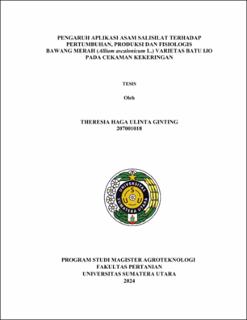| dc.description.abstract | Shallots are the vegetable crop with the highest production in Indonesia. However, the problem with cultivating shallots is that they are not resistant to environmental stress such as drought. The decrease in soil water content to 60% of available water has caused a drought stress effect on shallot plants. The strategy used to limit the harmful effects of lack of water on shallots is the application of salicylic acid. Salicylic acid plays an important role that enhances plant growth and development under drought stress conditions by reducing cell membrane damage in water-stressed plant leaves by reducing cellular lipid peroxidation and H2O2 accumulation. This research aims to study the growth, production and physiological responses of shallots under drought stress conditions with the application of salicylic acid. This research was carried out in the greenhouse of the Faculty of Agriculture, University of North Sumatra, Medan and was carried out from April to June 2024. This research used a factorial randomized block design with 2 treatment factors. The first factor of salicylic acid application consists of 4 levels, namely 0 mM (control), 0.5 mM, 1 mM and 1.5 mM. The second factor is the level of drought stress (field capacity) which consists of 3 levels, namely 80, 60 and 40% FC. The results showed that drought stress decreased plant height, number of leaves, number of tillers, shoot wet weight, root wet weight, shoot dry weight, root dry weight, number of tubers, tuber wet weight, tuber dry weight, chlorophyll a, b and total, carotenoids, relative water content of leaves but drought stress increased proline levels. Meanwhile, application of salicylic acid up to 1 mM can increased shoot wet weight, root wet weight, shoot dry weight, root dry weight, number of tubers, tuber wet weight, tuber dry weight, chlorophyll a, b and total, carotenoids, relative water content of leaves, proline levels. | en_US |


